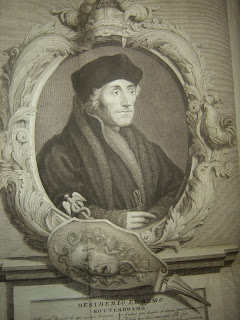In 1676 Serjeant-Chirurgeon
Richard Wiseman published his Severall
Chirurgicall Treatises. Richard Wiseman was a surgeon who served in the
Royalist army during the English Civil War, then as a Navy surgeon, and after
the Restoration, acted as one of Charles II’s surgeons. His book covers such
topics as a treatise on tumours, a treatise on ulcers, haemorrhoids, the King’s
Evill, a treatise on wounds, gun-shot wounds, fractures, and venereal disease. In
this week blog we look at just a few of the cases which he encountered.
 |
| The battle of Worcester 1651. Photograph by David Morrison. Reproduced by permission of the Chapter of Worcester Cathedral (U.K.) |
Just before the Battle of
Worcester, Wiseman was treating soldiers wounded in skirmishes. One man had a
musket ball lodged on the right side of his head. Wiseman’s servant assistant
William Clarke, whilst dressing the wound, felt the musket ball in the skull.
He called over Wiseman who noticed the man could not speak. They made a
circular incision, allowing the trapped blood to escape. Having cleaned the wound
with a sponge dipped in vinegar they filled the gap with lint. When the
bleeding had stopped some time later, they tried unsuccessfully to get the
bullet out. Using an instrument called a Trepan; they cut away another hole
nearby, which again released more trapped blood. This enabled them to pull out
the bullet and the depressed bone fragments. They now saw that there was a large
wound in the Dura Mater (one of the outer layers surrounding the brain).
Nevertheless they dressed the wounds in the skull and bandaged the head. Whilst
they did this, the man suddenly regained consciousness, and asked where he was.
He survived the operation, but after the chaos of the ensuing battle Wiseman
never saw him again.
An eighteenth century depiction of the battle of Worcester 1651. Photograph by David Morrison. Reproduced by permission of the Chapter of Worcester Cathedral (U.K.)
|
During the battle, a
royalist garrison held Fort-Royal just outside the city. The next case is of a
soldier in the fort, who during the fighting was using his bonnet to carry a
fresh supply of gunpowder to his fellows on the ramparts. He was just refilling
his bandoliers (ammunition pouches to hold the powder), when a fellow soldier
fired his musket too close to him. A spark from the musket ignited the powder
and both men were horribly burned. Wiseman and his assistants dressed the
wounds as best they could, covering the burns with some sort of oil and egg
white mixture. William Clark, managed to cure the first soldier, and the latter
was bandaged enough to allow him to escape the city.
In a case of a musket ball
entering a soldier through one side of his chest, which passed out between two
ribs on the other side of his body, they cleaned the wounds, and kept the hole
between the ribs open to allow discharge of any matter. The wound was later
cleaned, and the patient attended to after the battle by Wiseman’s assistant
William Clarke, who later lived in Bridgenorth. The soldier was concealed in
the city until he could make his escape.
Richard Wiseman's book on surgery. Photograph by David Morrison. Reproduced by permission of the Chapter of Worcester Cathedral (U.K.)
|
During the battle, a soldier
came to where Surgeon Wiseman was working. The soldier was still clutching his
broken sword and was covered in wounds, particularly around the head. Wiseman
saw that the hairy scalp of one side of his head was hanging down his neck, and
calling over his colleague William Clarke, they cleaned the wound with a
sponge. They noticed many fissures, and some fractures on the head caused by
various weapons. They freed the scalp of some bone fragments, and dressed the
wound, applying liniment. At this point the Parliamentarians broke into
Worcester. Wiseman decided it was time to leave in the middle of treating the
soldier. However his young assistant and servant William Clarke remained and
carried on treating the wounded even after the fighting was
over. He later wrote to Wiseman and told him about the case. Three days after
treating him, the soldier seemed in good spirits, but the head wounds were causing
discomfort, and Clarke loosened two of the stitches to vent the wounds. He
dressed penetrating wounds, and discarded damaged bone fragments. The soldier
eventually recovered, traveled to the Indies and then served in the Tower of
London.
 |
| A 1616 book on anatomy Wiseman might have seen. Photograph by David Morrison. Reproduced by permossion of the Chapter of Worcester Cathedral (U.K.) |
Meanwhile, Captain Smith,
leading a Company of Dragoons, was pursuing Wiseman and the defeated Royalist
soldiers as they fled from the battle. In the ensuing skirmish Smith was wounded
across the right Temporal Muscle (on the side of the head) and was bleeding to
death. He was brought to surgeon Wiseman’s quarters. Wiseman stitched his wound
and, lacking enough medicines, dressed it with a little wheat-flower and the
white of an egg, applying over it a compress which he described as being
pressed out of vinegar, and secured with a bandage. Three days later Wiseman
took off the bandages and found the wound to be healing. By this time, he had
managed to get medical supplies from an Apothecary and sprinkled the lips of
the wound with these. Two days afterwards he cut the stitches and applied “epuloticks” and after a couple more sets
of fresh dressings the man recovered.
David Morrison



.jpg)






